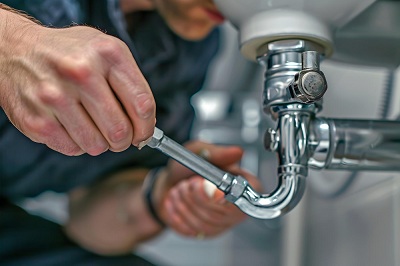Plumbing problems are an inevitable part of homeownership. From leaky faucets to clogged drains and burst pipes, these issues can cause frustration, water waste, and costly repairs if left unaddressed.
The good news? Many common plumbing problems can be fixed with simple DIY solutions, saving you money and time. However, some issues require professional help to prevent further damage.
In this guide, we’ll cover 10 of the most common plumbing problems, how to diagnose them, and whether you should fix them yourself or call a plumber.
1. Dripping Faucets
Why It Happens
A dripping faucet is one of the most common plumbing issues, usually caused by a worn-out washer, O-ring, or valve seat inside the faucet.
How to Fix It
✔ Turn off the water supply under the sink.
✔ Remove the faucet handle and unscrew the packing nut.
✔ Replace the washer or cartridge with a new one.
✔ Reassemble and turn the water back on.
💡 DIY Level: Beginner 💡 Call a Plumber If: The faucet is old and needs replacement.
2. Slow or Clogged Drains
Why It Happens
Drains clog due to a buildup of hair, grease, soap scum, food particles, or foreign objects.
How to Fix It
✔ Use a plunger to loosen the clog.
✔ Pour baking soda and vinegar down the drain, followed by hot water.
✔ Use a drain snake to remove hair and debris.
💡 DIY Level: Beginner 💡 Call a Plumber If: Multiple drains are clogged (could indicate a sewer line issue).
3. Running Toilet
Why It Happens
A running toilet is often due to a faulty flapper, fill valve, or float.
How to Fix It
✔ Check the flapper—replace if worn out.
✔ Adjust the float height to stop excess water flow.
✔ Replace the fill valve if it’s malfunctioning.
💡 DIY Level: Beginner 💡 Call a Plumber If: The problem persists despite replacing parts.
4. Low Water Pressure
Why It Happens
Low water pressure can be caused by mineral buildup in pipes, a faulty pressure regulator, or a hidden leak.
How to Fix It
✔ Check if the issue is isolated to one faucet or the entire house.
✔ Clean or replace clogged aerators on faucets.
✔ If the whole house is affected, check the main shut-off valve.
DIY Level: Intermediate Call a Plumber If: The issue persists or is affecting multiple fixtures.
5. Leaky Pipes
Why It Happens
Leaks occur due to corrosion, high water pressure, or loose connections.
How to Fix It
✔ Tighten pipe joints with a wrench.
✔ Apply pipe sealant or plumber’s tape to small leaks.
✔ Use a pipe repair clamp for temporary fixes.
DIY Level: Intermediate
Call a Plumber If: The leak is large, behind walls, or under the foundation.
6. Water Heater Issues
Why It Happens
A water heater may fail due to sediment buildup, a faulty thermostat, or a broken heating element.
How to Fix It
✔ Flush the tank to remove sediment.
✔ Check the thermostat settings (should be around 120°F).
✔ Replace heating elements if there’s no hot water.
DIY Level: Advanced Call a Plumber If: The unit is leaking or making loud noises.
7. Burst Pipes
Why It Happens
Pipes burst due to freezing temperatures, high water pressure, or corrosion.
How to Fix It
✔ Shut off the main water supply immediately.
✔ Drain the pipes by opening faucets.
✔ Use pipe repair clamps or epoxy putty as a temporary fix.
DIY Level: Emergency Temporary Fix
Call a Plumber Immediately! This is a serious issue requiring professional repair.
8. Sewer System Backup
Why It Happens
A sewer backup can be caused by tree roots, blockages, or damaged sewer lines.
How to Fix It
✔ Stop using water and check for multiple drain clogs.
✔ Avoid flushing toilets to prevent overflowing.
✔ Call a plumber to inspect and clear the blockage.
DIY Level: Do NOT attempt DIY Call a Plumber Immediately! This issue requires professional sewer cleaning.
9. Garbage Disposal Jams
Why It Happens
Garbage disposals can jam due to food buildup, grease, or hard objects like bones.
How to Fix It
✔ Turn off the power to the disposal.
✔ Use a hex key wrench to manually rotate the blades.
✔ Reset the disposal using the red reset button underneath.
DIY Level: Beginner Call a Plumber if The motor is burnt out or the disposal is leaking.
10. Noisy Pipes (Banging or Whistling)
Why It Happens
Noisy pipes may be due to water hammer, loose fittings, or high water pressure.
How to Fix It
✔ Install a water hammer arrestor to absorb pressure.
✔ Check pipe connections and secure loose pipes.
✔ Adjust the water pressure regulator.
💡 DIY Level: Intermediate 💡 Call a Plumber If: The noise persists or pipes show signs of damage.
When to Call a Professional Plumber
While many plumbing issues can be fixed DIY, some require professional expertise. Call a plumber if:
✔ You have major leaks, burst pipes, or flooding.
✔ There’s sewer backup or foul odors in your home.
✔ Water pressure issues affect the entire house.
✔ Your water heater is leaking or not heating.
✔ You’re unsure or uncomfortable handling a repair.
Final Thoughts
Plumbing problems can be a headache, but knowing how to troubleshoot and fix common issues can save you money, time, and frustration.
✔ Tackle simple repairs like fixing leaks, unclogging drains, and replacing washers.
✔ For serious issues like burst pipes, sewer backups, or major leaks, call a professional.
✔ Regular maintenance can prevent costly plumbing disasters in the future!
Pro Tip: Keep basic plumbing tools like a plunger, pipe wrench, drain snake, and plumber’s tape in your home for quick fixes.




